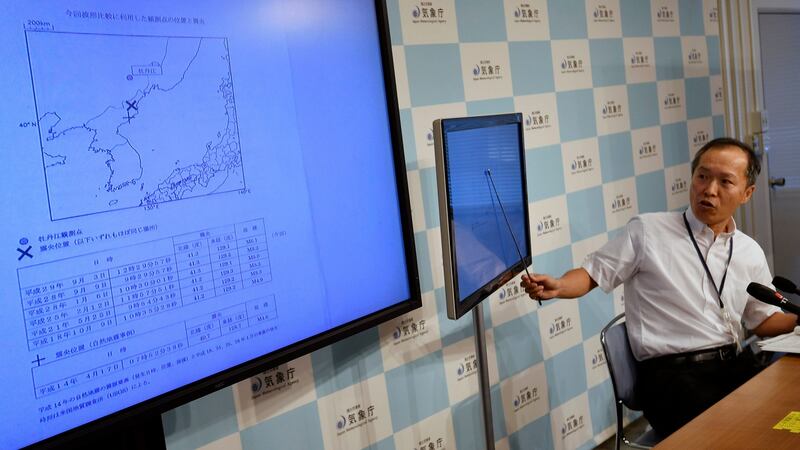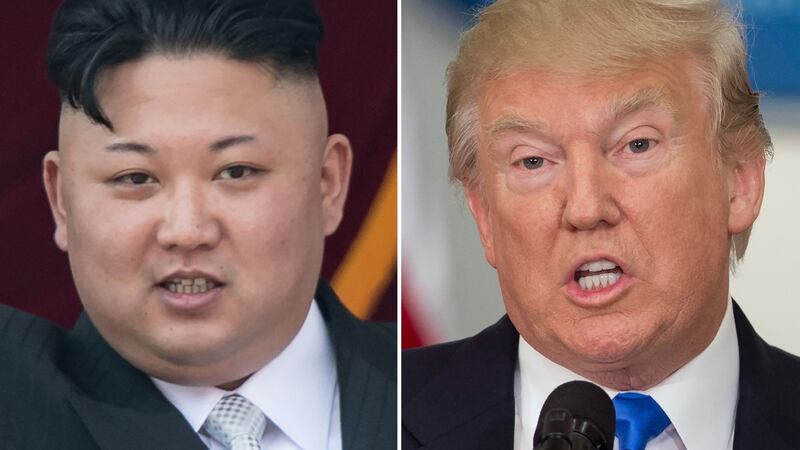North Korea says it has tested a powerful hydrogen bomb that can be loaded on to an intercontinental ballistic missile, in a move that is expected to increase pressure on Donald Trump to defuse the growing nuclear crisis on the Korean peninsula.
In an announcement carried on state TV, North Korea said the test, its sixth since 2006, had been a “complete success” and involved a “two-stage thermonuclear weapon” with “unprecedented” strength.
There has been no independent verification of the North’s claims that it has achieved a key goal in its nuclear programme - the ability to miniaturise a warhead so that it can fit on a long-distance missile.
Hours earlier, the regime released footage of what it claimed was a hydrogen bomb that would be loaded on to a new ICBM.

The TV announcement – accompanied by patriotic music and images of North Korean scenery and military hardware – said the test had been ordered by the country’s leader, Kim Jong-un.
The explosion was heralded by a 6.3 magnitude earthquake about six miles (10km) from North Korea’s Punggye-ri nuclear test site in the north-east of the country. It was felt over the Chinese border in Yanji.
South Korea’s meteorological administration estimated the blast yield at between 50 to 60 kilotons, or five to six times stronger than North Korea’s fifth test in September last year.
100 kilotons
Kim Young-woo, the head of South Korea’s parliamentary defence committee said later that the yield was as high as 100 kilotons. One kiloton is equivalent to 1,000 tons of TNT.
The previous nuclear blast in North Korea is estimated by experts to have been about 10 kilotons.
Sunday’s test – the first since Mr Trump took office in January – offers further evidence that North Korea is moving perilously close to developing a nuclear warhead capable of being fitted on to an ICBM that can strike the US mainland.
Since it conducted its first nuclear test just over a decade ago, the regime has strived to refine the bombs’ design and reliability, as well as increasing their yield.

Hydrogen bombs are far more powerful than the atomic weapons the North is believed to have tested so far. Whatever its eventual yield, Sunday’s test was “a staged thermonuclear weapon” that represents a significant advance in Pyongyang’s weapons programme, said Jeffrey Lewis of the California-based Middlebury Institute of International Studies.
As the US and countries in the region analysed data resulting from the quake, Japan’s government was the first to state publicly that it was confident the shockwaves came from an underground nuclear explosion in North Korea.
The US Geological Survey and China’s Earthquake Administration said they had detected a suspected explosion that caused a 6.3 magnitude earthquake.
It’s an explosion
The USGS said the tremor was located 24km north-east of Sungjibaegam in North Hamgyeong province. “It’s an explosion rather than an earthquake,” said Jana Pursley, a USGS geophysicist.
The Chinese earthquake administration said in a statement on its website that the shock, which occurred around 11.30am local time, was recorded at a depth of zero metres.

China’s foreign ministry said in a statement: “The Democratic People’s Republic of Korea has once again conducted a nuclear test in spite of widespread opposition from the international community. The Chinese government resolutely opposes and strongly condemns it.”
South Korea was convening an emergency meeting of its national security council to discuss the possible cause of the quake, according to local media.
Japan’s government said it would lodge a strong protest pending confirmation that the quakes were caused by nuclear tests. “If North Korea has indeed gone ahead with a nuclear test, it is completely unacceptable and we must lodge a strong protest,” said the prime minister, Shinzo Abe.
His defence minister, Itsunori Onodera, said “sniffer” planes capable of detecting radioactive fallout had been deployed to monitor the aftermath of the blast. “We’ll do our best to collect information,” he said, according to public broadcaster NHK.
Second tremor
South Korea’s meteorological administration later challenged reports that a second earthquake had occurred near the same nuclear test site. Earlier reports citing China’s earthquake agency said a second quake had been detected eight minutes after the first.
The agency later said the second tremor could have been caused by a cave-in near the underground nuclear test site.
Zhang Zhiyuan, a journalist for the Chinese newspaper Yanji News, said he had felt the earthquake caused by the nuclear blast. "I was having lunch in a restaurant when the lights just started shaking," Mr Zhang, who lives and works near China's border with North Korea, told the Guardian. "People here have all run outside of their apartments."
Mr Trump last month threatened to unleash “fire and fury” against the regime if it continued to threaten the US and its allies with ballistic missiles.
In a telephone call on Sunday morning Japan time, Trump and Abe “reaffirmed the importance of close cooperation between the United States, Japan, and South Korea in the face of the growing threat from North Korea”, according to a statement.
Sunday’s tests again demonstrated North Korea’s ability to skirt sanctions targeting its missile and weapons technology. UN security council measures ban the regime from testing nuclear or ballistic missile technology, but that did not prevent it from carrying out two nuclear tests and launching more than 20 ballistic missiles last year alone.
North Korea in 2016 conducted its fourth and fifth nuclear tests, saying the fourth in January that year was a successful hydrogen bomb test, although experts questioned whether it was a fully fledged hydrogen bomb.
The fifth nuclear test, in September 2016, was measured to be possibly North Korea’s biggest detonation ever, but the earthquake it caused was still not believed to be big enough to indicate a full thermonuclear test.
Tests
The regime detonated its first nuclear device in 2006, followed by tests in 2009 and 2013.
Hours before reports of Sunday’s nuclear test emerged, the regime said it had developed a more advanced nuclear weapon that had “great destructive power”, and that Kim had inspected a hydrogen bomb that would be loaded on to a new ICBM.
Pyongyang test launched two ICBM-class missiles in July that potentially had a range of about 10,000km, putting the mainland US within reach.

Under Kim, North Korea has defied several rounds of UN sanctions and ploughed resources into building working nuclear weapons and missiles with enough range to deliver them as far away as the US mainland – a development that would considerably strengthen Pyongyang’s hand in any negotiations with Washington.
The North’s official KCNA news agency said the hydrogen bomb showcased in photographs at the weekend was adjustable to hundreds of kilotons in explosive power and could be detonated at high altitudes, with its indigenously produced components allowing the country to build as many nuclear weapons as it wants.
Kim visited the country’s Nuclear Weapons Institute and “watched an H-bomb to be loaded into new ICBM”, KCNA said.
Juche is North Korea’s homegrown go-it-alone ideology that is a mix of Marxism and extreme nationalism preached by state founder Kim Il-sung, the current leader’s grandfather.
Weapons programme
While it is difficult to independently verify North Korean claims about its missile and nuclear weapons programmes, no one doubts that it is improving its capability with each new test.
However, the extent of its ability to consistently miniaturise nuclear warheads so they can fit on long-range missiles remains unclear.
“Though we cannot verify the claim, (North Korea) wants us to believe that it can launch a thermonuclear strike now, if it is attacked,” Adam Mount, a senior fellow at the Center for American Progress, told Associated Press.
The Guardian










